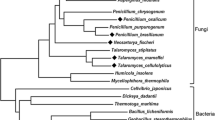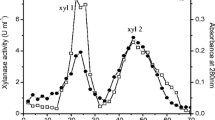Abstract
Crude extracts of cauliflower florets had high xyloglucan endotransglucosylase (XET) activity, but this was largely lost after partial purification and de-salting. Activity was restored (promoted up to 40-fold) by any of a wide variety of inorganic and organic salts. Optimum concentrations for Na+, K+ and NH4 + salts were typically ~300 mM. The chlorides of Ca2+, Mg2+, Al3+ and La3+ were optimally active at lower concentrations (e.g. 0.1 mM LaCl3), but became inhibitory at higher concentrations (e.g. 5 mM LaCl3). Some anionic polysaccharides at 0.04–0.2% w/v (e.g. gum arabic, pectin and hypochlorite-oxidised xyloglucan) promoted the XET activity of de-salted enzyme, especially if a sub-optimal concentration of NaCl was also present; others (e.g. homogalacturonan, 4-O-methyl-glucuronoxylan and alginate) were inhibitory. Similar ionic effects were noted on the XET activity of the Arabidopsis protein XTH24 (heterologously expressed by insect cells); in this case carboxymethylcellulose was also stimulatory. To look for endogenous modulators of XET activity, we prepared a cold-water extract of cauliflower florets; after boiling and centrifugation, the supernatant [boiled cauliflower preparation (BCP)] promoted the XET activity of de-salted cauliflower enzyme and of XTH24. About half the activator present in BCP was an ethanol-precipitable, anionic polymer of apparent Mr <5,000. After acid hydrolysis the polymer yielded much arabinose and galactose, and small amounts of galacturonic and glucuronic acids amino acids were also present. The polymer may thus contain arabinogalactan-proteins. We suggest that acidic polymers and/or other apoplastic ions are naturally occurring regulators of XET action in vivo, and may thus control cell wall assembly, loosening, and growth.






Similar content being viewed by others
Abbreviations
- AGP :
-
Arabinogalactan-protein
- BCP :
-
Boiled cauliflower preparation (cold-water-extract of cauliflower florets that was then boiled)
- CMC :
-
Carboxymethylcellulose
- DE :
-
Degree of esterification
- GalA :
-
Galacturonic acid
- GlcA :
-
Glucuronic acid
- K av :
-
Elution volume relative to those of Blue Dextran (K av=0) and glucose (K av=1)
- TFA :
-
Trifluoroacetic acid
- V 0 :
-
Void volume (centre of elution peak of Blue Dextran)
- V i :
-
Totally included volume (centre of elution peak of glucose)
- XEH :
-
Xyloglucan endohydrolase (activity)
- XET :
-
Xyloglucan endotransglucosylase (activity)
- XLLGol :
-
A xyloglucan-derived oligosaccharide, xylose3·glucose3·galactose2·glucitol
- XTH :
-
Xyloglucan endotransglucosylase/hydrolase (protein)
- µ :
-
Ionic strength
References
Almeida DPF, Huber DJ (1999) Apoplastic pH and inorganic ion levels in tomato fruit: a potential means for regulation of cell wall metabolism during ripening. Physiol Plant 105:506–512
Aubert D, Herzog M (1996) A new cDNA encoding a xyloglucan endo-transglycosylase-related polypeptide (AtXTR8) preferentially expressed in seedling, root and stem of Arabidopsis thaliana. Plant Sci 121:187–196
Bar Nun N, Mor A, Mayer AM (1999) A cofactor requirement for polygalacturonase from Cuscuta campestris. Phytochemistry 52:1217–1221
Campbell P, Braam J (1999) In vitro activities of four xyloglucan endotransglycosylases from Arabidopsis. Plant J 18:371–382
Chun JP, Huber DJ (1998) Polygalacturonase-mediated solubilization and depolymerization of pectic polymers in tomato fruit cell walls—regulation by pH and ionic conditions. Plant Physiol 117:1293–1299
Cutillas-Iturralde A, Lorences EP (1997) Effect of xyloglucan oligosaccharides on growth, viscoelastic properties, and long-term extension of pea shoots. Plant Physiol 113:103–109
Dawson RMC, Elliott DC, Elliott WH, Jones KM (1986) Data for Biochemical Research. Clarendon, Oxford
Fanutti C, Gidley MJ, Reid JSG (1993) Action of a pure xyloglucan endo-transglycosylase (formerly called xyloglucan-specific endo-(1→4)-β-d-glucanase) from the cotyledons of germinated nasturtium seeds. Plant J 3:691–700
Farkaš V, Sulová Z, Stratilova E, Hamma R, Maclachlan G (1992) Cleavage of xyloglucan by nasturtium seed xyloglucanase and transglycosylation to xyloglucan subunit oligosaccharides. Arch Biochem Biophys 298:365–370
Fry SC (1989a) The structure and functions of xyloglucan. J Exp Bot 40:1–11
Fry SC (1989b) Cellulases, hemicelluloses and auxin-stimulated growth: a possible relationship. Physiol Plant 75:532–536
Fry SC (2000) The growing plant cell wall: chemical and metabolic analysis reprint edition. Blackburn, Caldwell, N.J.
Fry SC, Smith RC, Renwick KF, Martin DJ, Hodge SK, Matthews KJ (1992) Xyloglucan endotransglycosylase, a new wall-loosening enzyme activity from plants. Biochem J 282: 821–828
Goldberg R, Pierron M, Durand L, Mutaftschiev S (1992) In vitro and in situ properties of cell wall pectinmethylesterases from mung bean hypocotyls. J Exp Bot 43:41–46
Grignon C, Sentenac H (1991) pH and ionic conditions in the apoplast. Annu Rev Plant Physiol Plant Mol Biol 42:103–128
Hayashi T (1989) Xyloglucans in the primary cell wall. Annu Rev Plant Physiol Plant Mol Biol 40:139–168
Hayashi T, Takeda T, Ogawa K, Mitsuishi Y (1994) Effects of degree of polymerization on the binding of xyloglucans to cellulose. Plant Cell Physiol 35:1199–1205
Hetherington PR, Fry SC (1993) Xyloglucan endotransglycosylase activity in carrot cell suspensions during cell elongation and somatic embryogenesis. Plant Physiol 103:987–992
Hoson T (1993) Regulation of polysaccharide breakdown during auxin-induced cell wall loosening. J Plant Res 106:369–381
Ito H, Nishitani K (1999) Visualization of EXGT-mediated molecular grafting activity by means of a fluorescent-labeled xyloglucan oligomer. Plant Cell Physiol 40:1172–1176
Jork H, Funk W, Fischer W, Wimmer H (1994) Thin layer chromatography: reagents and detection methods, vol 1b. Physical and chemical detection methods; activation reactions, reagent sequences, reagents II. VCH, Weinheim
Lohaus G, Pennewiss K, Sattelmacher B, Hussmann M, Muehling KH (2001) Is the infiltration-centrifugation technique appropriate for the isolation of apoplastic fluid? A critical evaluation with different plant species. Physiol Plant 111:457–465
McDougall GJ, Fry SC (1990) Xyloglucan oligosaccharides promote growth and activate cellulase: evidence for a role of cellulase in cell expansion. Plant Physiol 93:1042–1048
Nishitani K, Tominaga R (1992) Endo-xyloglucan transferase, a novel class of glycosyltransferase that catalyzes transfer of a segment of xyloglucan molecule to another xyloglucan molecule. J Biol Chem 267:21058–21064
Nooy AEJ de, Besemer AC, van Bekkum H (1995) Highly selective nitroxyl radical-mediated oxidation of primary alcohol groups in water-soluble glucans. Carbohydr Res 269:89–98
Potter I, Fry SC (1993) Xyloglucan endotransglycosylase activity in pea internode: effects of applied gibberellic acid. Plant Physiol 103:235–241
Pritchard J, Hetherington PR, Fry SC, Tomos AD (1993) Xyloglucan endotransglycosylase activity, microfibril orientation and the profiles of cell wall properties along growing regions of maize roots. J Exp Bot 44:1281–1289
Redgwell RJ, Fry SC (1993) Xyloglucan endotransglycosylase activity increases during kiwifruit (Actinidia deliciosa) ripening: implications for fruit softening. Plant Physiol 103:1399–1406
Rose JK, Braam J, Fry SC, Nishitani K (2002) The XTH family of enzymes involved in xyloglucan endotransglucosylation and endohydrolysis: current perspectives and a new unifying nomenclature. Plant Cell Physiol 43:1421–1435
Saab IN, Sachs MM (1996) A flooding-induced xyloglucan endo-transglycosylase homolog in maize is responsive to ethylene and associated with aerenchyma. Plant Physiol 112:385–391
Serpe MD, Nothnagel EA (1999) Arabinogalactan-proteins in the multiple domains of the plant cell surface. Adv Bot Res 30:207–289
Smith RC, Fry SC (1991) Endotransglycosylation of xyloglucans in plant cell suspension cultures. Biochem J 279:529–535
Smith RC, Matthews PR, Schunmann PHD, Chandler PM (1996) The regulation of leaf elongation and xyloglucan endotransglycosylase by gibberellin in ‘Himalaya’ barley (Hordeum vulgare L). J Exp Bot 47:1395–1404
Steele NM, Fry SC (2000) Differences in catalytic properties between native isoenzymes of xyloglucan endotransglycosylase (XET). Phytochemistry 54:667–680
Steele NM, Sulová Z, Campbell P, Braam J, Farkaš V, Fry SC (2001) Ten isoenzymes of xyloglucan endotransglycosylase from plant cell walls select and cleave the donor substrate stochastically. Biochem J 355:671–679
Tabuchi A, Mori H, Kamisaka S, Hoson T (2001) A new type of endo-xyloglucan transferase devoted to xyloglucan hydrolysis in the cell wall of azuki bean epicotyls. Plant Cell Physiol 42:154–161
Takeda T, Furuta Y, Awano T, Mizuno K, Hayashi T (2002) Suppression and acceleration of cell elongation by integration of xyloglucans in pea stem segments. Proc Natl Acad Sci USA 99:9055–9060
Thiyagarajah M, Fry SC, Yeo AR (1996) In-vitro salt tolerance of cell wall enzymes from halophytes and glycophytes. J Exp Bot 47:1717–1724
Thompson JE, Fry SC (2000) Evidence for covalent linkage between xyloglucan and acidic pectins in suspension-cultured rose cells. Planta 211:275–286
Thompson JE, Fry SC (2001) Restructuring of wall-bound xyloglucan by transglycosylation in living plant cells. Plant J 26:23–34
Thompson JE, Smith RC, Fry SC (1997) Xyloglucan undergoes inter-polymeric transglycosylation during binding to the plant cell wall in vivo: evidence from 13C/3H dual labelling and isopycnic centrifugation in caesium trifluoroacetate. Biochem J 327:699–708
Vissenberg K, Martinez-Vilchez IM, Verbelen JP, Miller JG, Fry SC (2000) In-vivo co-localization of xyloglucan endotransglycosylase activity and its donor substrate in the elongation zone of Arabidopsis roots. Plant Cell 12:1229–1237
Vissenberg K, van Sandt V, Fry SC, Verbelen J-P (2003) Xyloglucan endotransglucosylase action is high in the root elongation zone and in the trichoblasts of all vascular plants from Selaginella to Zea mays. J Exp Bot 54:335–344
Xu W, Purugganan MM, Polisensky DH, Antosiewicz DM, Fry SC, Braam J (1995) Arabidopsis TCH4, regulated by hormones and the environment, encodes a xyloglucan endotransglycosylase. Plant Cell 7:1555–1567
Xu W, Campbell P, Vargheese AK, Braam J (1996) The Arabidopsis XET-related gene family: environmental and hormonal regulation of expression. Plant J 9:879–889
Zurek DM, Clouse SD (1994) Molecular cloning and characterization of a brassinosteroid-regulated gene from elongating soybean (Glycine max L.) epicotyls. Plant Physiol 104:161–170
Acknowledgements
We are very grateful to Dr. Janet Braam (Rice University, Houston, Texas) for providing the XTH24 preparation. T.T. thanks the Japan Society for Promotion of Science (JSPS) for the award of a Fellowship. We thank the Biotechnology and Biological Sciences Research Council (UK) for financial support.
Author information
Authors and Affiliations
Corresponding author
Rights and permissions
About this article
Cite this article
Takeda, T., Fry, S.C. Control of xyloglucan endotransglucosylase activity by salts and anionic polymers. Planta 219, 722–732 (2004). https://doi.org/10.1007/s00425-004-1267-9
Received:
Accepted:
Published:
Issue Date:
DOI: https://doi.org/10.1007/s00425-004-1267-9




